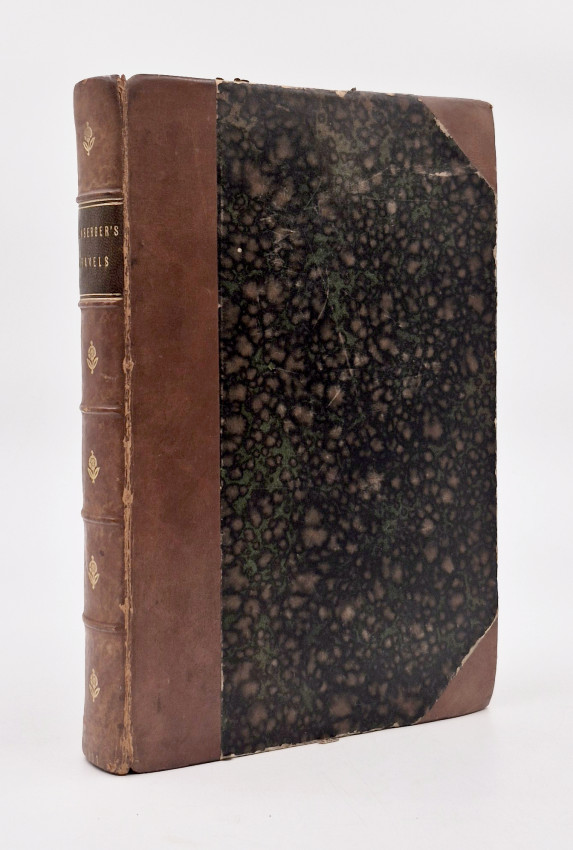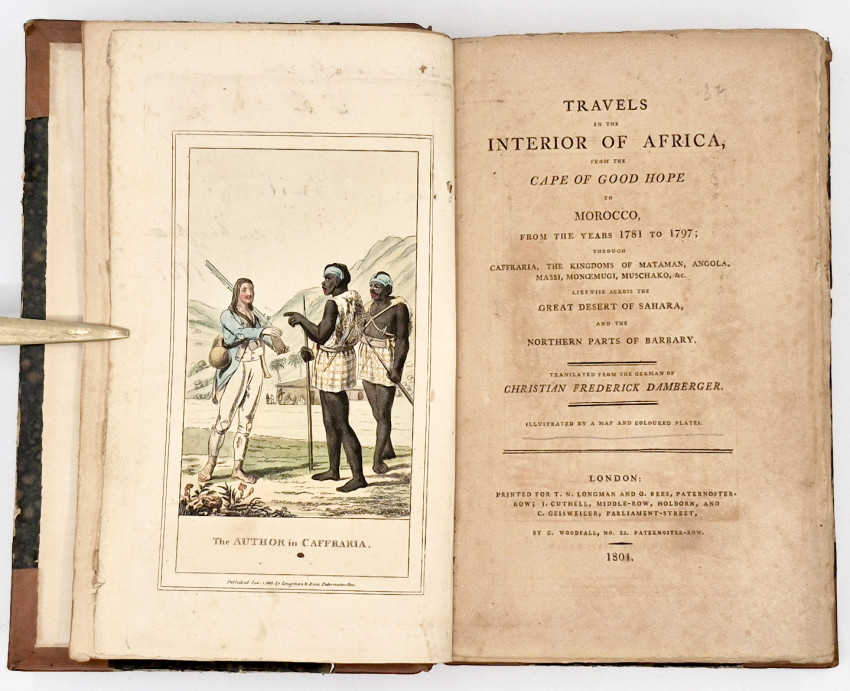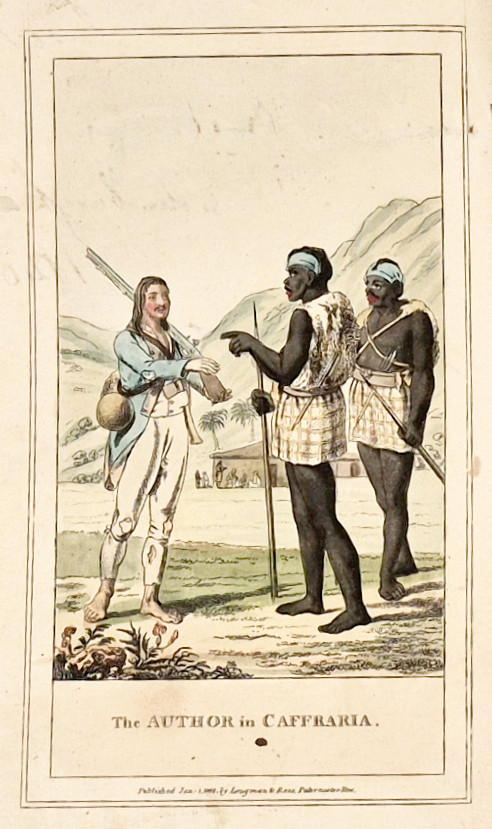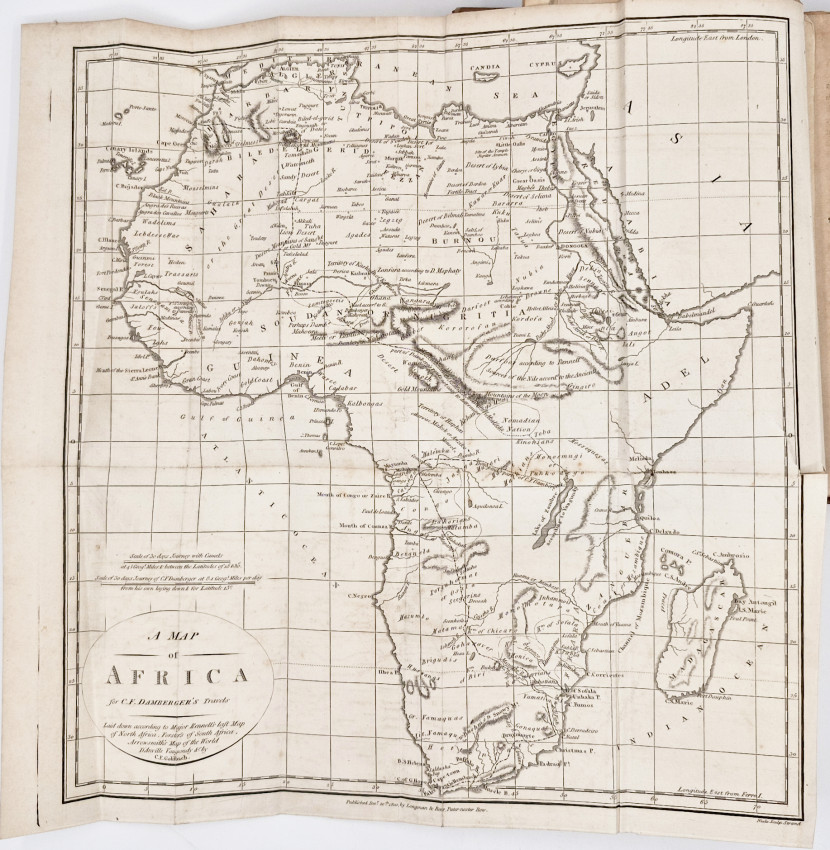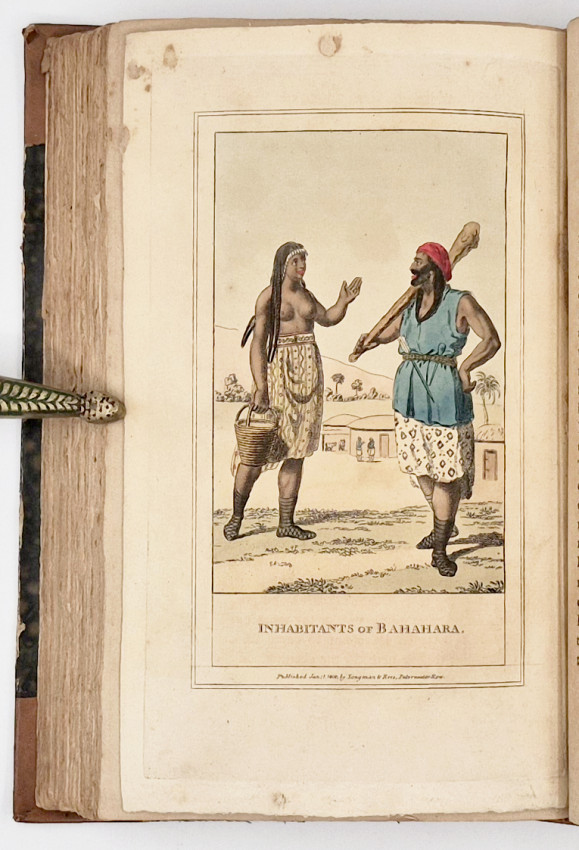Translated from the German of Christian Frederick Damberger. Illustrated by a map and colour plates.
New Edition, 2 volumes in 1, 222 + 228 pages, half calf, marbled paper sides (edges worn), engraved frontispiece (slightly damaged by an attempt to erase an ink inscription from the back of the plate), 2 hand-coloured plates, folding map carelessly folded and slightly torn at bottom fold, edges uncut, title page browned and the text browned throughout.
Royal Collection Trust (https://www.rct.uk/collection/1141446/travels-in-the-interior-of-africa-from-the-cape-of-good-hope-to-morocco)
Travels through the Interior of Africa, translated from the German Landreise in das Innere von Afrika, is a fabricated travel account by the pseudonymous author Christian Friedrich Damberger. First published at Leipzig in 1801, the book was the third of three fictional travels believed to have been written by the same author as part of an elaborate hoax.
The book is written as an account of the travels of Christian Damberger from Amsterdam to the Cape of Good Hope and his subsequent journey back to Europe. On his adventure, Damberger states that he first travelled across territories occupied by the semi-nomadic Khoekhoen people (referred to as ‘Hottentot’, a pejorative name used to refer to semi-nomadic people in southern Africa until the mid-twentieth century) into ‘Caffraria’ (a pejorative name used in the late-eighteenth century for the lands now forming Botswana and Zimbabwe), then northward to the Zambezi river, through Angola, the Kingdom of Matamba and into the Congo basin. After visiting several Congolese kingdoms, he continued north to Lake Chad, followed the course of the River Niger to Timbuktu, crossed the Sahara Desert and arrived in Morocco. Such an extensive journey was believed to be impossible but due to the impressive detail and plausible information found in the book, publishers and the reading public immediately fell for the deception — indeed the French and English translation rights were sold before the first German edition was printed. The account was wildly popular, particularly in the English-speaking world where interest in African exploration was very high due to the recent expeditions in search of Timbuktu organised by the African Association. The English translation went through seven editions in 1801.
Shortly after publication, the Leipzig printer Gottfried Martini became suspicious of Damberger’s manuscript. The author, a cabinet-maker, had made himself known to the printer, stating he was taking some time to relax in Wittenberg after the arduous journey through Africa and offered him the copyright of his manuscript. On the publication of the Travels, articles in Gottingen journal Literatur Zeitung and in the Allgemeine Literatur Zeitung of Jena showed that parts of the text had been lifted from other travel accounts, particularly recent accounts written by the Egyptian printer Zacharias Taurinius and the shoemaker Joseph Schrödter. Martini contacted the publishers of the other accounts and compared the three manuscripts. He soon noticed that the handwriting was the same in all three. When taken to court, ‘Damberger’ immediately admitted the deception with the manuscripts but maintained that the travels described were authentic. He stated that he was actually Zacharias Taurinius and had taken the name Damberger from a fellow traveller who he believed was now on his way to Suriname. He also claimed that Schrödter was a real person, living in Hamburg, and that the manuscript was only in his hand because Schrödter was unable to write. This information was also shown to be false and soon suspicion came to rest upon a Wittenberg magistrate named Junge, about whom little is known. The fraud was widely discussed in journals across Europe and the book was quickly withdrawn from the press.
- Size: 8vo (225 x 150 mm)
- Sold By: Clarke's Africana & Rare Books
- Contact Person: Paul Mills
- Country: South Africa
- Email: [email protected]
- Telephone: 021 794 0600
- Preferred Payment Methods: Visa & Mastercard via PayGate secure links and Bank transfers.
- Trade Associations: ABA - ILAB, SABDA


